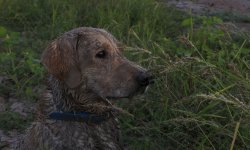Good post, Mark. We had a stretch of time down here when there was an abundance of smart weed. It lasted almost 5 years. In that time I would find a nice honey hole with smart weed and some grassy patches. Over those years I would normally use anywhere from 11 to 33 decoys and Greg, the only even number I would put out was 2. I did enjoy what you had to say, by the way. Now at the age of 81, I normally use 5 to 7 decoys. Most of the time I will use 3 teal along with 2 or 4 big ducks. My decoys are always placed up to 15 feet from shore but no farther. That is what my retrieving stick can get without me having to step in the mud.
Anyway, since puddle ducks are gregarious, sometimes those numbers are enticing to incoming birds. If I am hunting the Rio Grande I normally always tried to set up close to a sandy island or a very shallow area and then I always incorporated the use of the full body decoys like you use in a corn field. When placed on a stake a small breeze would keep them moving all the time. I made darn sure that they were always placed in the shallow water because that is what I observed the ducks doing. They seemed right at ease standing in 2 or 3" of water but I never saw many of them sitting or standing on the sand.
On the pond that I used to hunt that was not too far from the Rio Grande, I once found about a 10' branch that was about 8" in diameter.
That year the rancher brought in his dozer and cleaned all the weeds out and at the same time instead of some dandy shallow water he dozed out some more material that ended up with the pond being about two to three feet deep. That time I took my battery operated drill using a 9/16th bit. I drilled about a dozen or so holes with some closer together than others and once again used those life sized decoys with short pieces of 1/2" wood dowels holding up the decoys. Some of the log was slightly submerged and I used full body feeding decoys there. It worked well because it gave the look that the pond was shallow and inviting to the ducks. With a few of the old style Herter model 72 decoys that do such a great job with hardly any breeze at all, it all worked just fine. Just so you know I used two 48" wood dowels to hold the log in place.
Finally the biggest change I have made in the past decade was to begin using more and more black ducks. If there ever was a black duck in New Mexico it was because the poor bird got totally lost. When I had decoys needing paint I just went to the hardware store and bought cans of flat black spray paint. Yup, even the beaks got painted. They worked just fine. Back around 09 I bought a half dozen black duck decoys from Cabelas and along with my Mexican duck from Steve, things seem to work just fine. Now I need to say just one thing. I live in an area that has very few clouds. Normally my best days are those that we call "severe clear". You can get away with beaks painted black etc. But if the area where you live has lots of clouds, that is when ducks seem to be darn particular where they go. Some of the folks have talked about good looking decoys. Yes, I am sure it works. I just don't hunt on cloudy, rainy or snowy days.
Al
Mark, your environment normally will dictate the number of decoys that you use.
Have you ever tried leaving your decoy bag on the shore line next to the water. I did. I even left my decoy bag in the decoy sled/boat on a sandy island just a few feet from my decoys. Never ever had birds flare because of it. You should also try sitting in the wide open with maybe your back up against the stalk of a wild sunflower plant. Just don't move. It is amazing what happens. Fun, too! Ducks don't pay much attention to inanimate objects. If you can be one its called being up close and personal. I had three different dogs that could do that and they were Chili, Habanero aka Habi and Chipotle aka Chip. When out in the open I would always have them wear camo so that their bodies would covered. After saying that I will be using a picture of Chip with no camo jacket. We were hunting teal. Almost anything goes when you are hunting just teal. The second picture is of the area where we sat. Chip could run straight ahead from where he was. We sat maybe just 6 to 8' from the water's edge.




